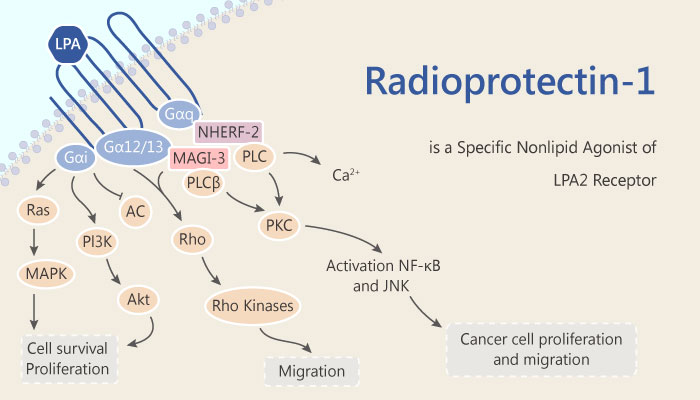Rapidly proliferating cells are highly sensitive to ionizing radiation and can undergo apoptosis if the oxidative and genotoxic injury exceed the defensive and regenerative capacity of the cell. Previous studies have established the antiapoptotic action of the growth factor-like lipid mediator lysophosphatidic acid (LPA). And activation of the LPA2 GPCR has been hypothesized to elicit antiapoptotic and regenerative actions of LPA. Additionally, based on this hypothesis, a study from Bryan Kuo developed a novel nonlipid agonist of LPA2. A novel compound, they designated Radioprotectin-1 (RP-1).

Radioprotectin-1 (RP-1), which is a high-potency specific agonist of the human LPA2. Specially, it has no detectable effect on the other LPA1/3/4/5 GPCR or the type 1 sphingosine-1-phosphate GPCR. Besides, the EC50 value of Radioprotectin-1 (RP-1) for LPA2 is 5 pM.
In vitro, Radioprotectin-1 functioned as a full agonist at the human ortholog of LPA2. Furthermore, Radioprotectin-1 (0-3 μM; 15 minutes) effectively reduced apoptosis induced by γ-irradiation and the radiomimetic drug Adriamycin in cells that expressed LPA2 either endogenously or after transfection.
In addition, in vivo, Radioprotectin-1 is a high-potency specific agonist of the murine LPA2 GPCR. Moreover, Radioprotectin-1 (0.1 mg/kg, 0.3 mg/kg, s.c., every 12 hours, for 3 days) decreases the mortality of C57BL/6 mice in models of the hematopoietic acute radiation syndromes (HE-ARS) and gastrointestinal acute radiation syndromes (GI-ARS).
To conclude, the data suggested that the LPA2-specific agonist RP-1 exerts its radioprotective and radiomitigative action through specific activation of the upregulated LPA2 GPCR in Lgr5+ stem cells.